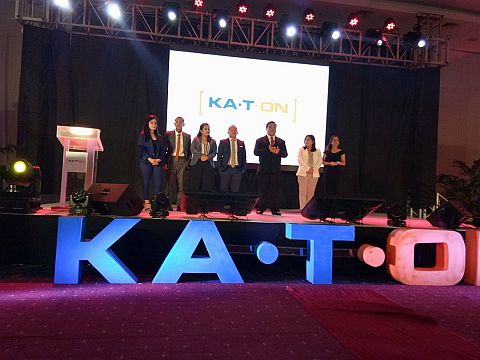
The Board of Trustees of Barangay Impact Visayas (BIV) Management and Support Services Corporation during the recent launching of BIV’s KA•T•ON Junior High School tutorial program which will cover four Cebu City barangays, namely: Guadalupe, Apas, Cogon Ramos and Luz; and Barangay Centro in Mandaue City. The program hopes to address the increasing dropout rates in public high schools. CDN PHOTO/ROSALIE ABATAYO
What are the chances of a Filipino child dropping out of a public high school?
According to the Philippine Institute of Development Studies (PIDS), 57 percent.
Of that number, 44% drop out of school due to a “lack of interest” caused by an unconducive learning environment, the students’ poverty mindset, an addiction to online gaming, and gaps in the fundamentals of learning.
Congested classrooms and the students’ unaddressed difficulties in hurdling complex subject matters, coupled with the stigma of poverty and the temptation of online gaming demotivate the students, the PIDS study added.
To keep junior high school students motivated to stay in school and reduce dropout risks, the Barangay Impact Visayas Management and Support Services Corporation partnered with four Cebu City barangays namely: Guadalupe, Apas, Cogon Ramos, and Luz to conduct a tutorial program called KA•T•ON (Kaon + Tuon).
The program will also be implemented in Barangay Centro, Mandaue City.
It all began back in December 2015, when Barangay Impact Visayas (BIV) collaborated with Barangay Luz to launch KA•T•ON tutorial sessions in the village.
BIV Chairman and CEO Monica Alipe-Enriquez, said that they wanted to immediately address the alarming dropout rate in public high schools, prompting them to go directly to the barangay level.
“The barangay was our best entry to touch based with our targeted beneficiaries with the fact that they knew their constituents that could qualify in the program,” said Alipe-Enriquez.
By January 2016, BIV launched the first cycle of KA•T•ON in Barrio Luz, in coordination with its barangay officials who provided them a list of 40 students and a place for them to conduct their tutorials and other activities.
Since the program kicked off, there has been significant improvements in the academic performance among the tutees.
Ronnel Lambayong was a Grade 8 student when he joined the program as one of the pioneer tutees of the Barangay Luz.
According to Ronnel, before he joined the program, he felt left behind in his subjects especially Mathematics.
But just a year after, he consistently participated in the Kat-on sessions. Ronnel has reinvented himself as a Math wizard, even representing his school in a Math Challenge competition.
“Pagkahibaw sa among mga tutor sa Kat-on nga apil ko sa contest, ila jud ko gitabangan para makapangandam ko. Ila ko gihatagan og mga formula para inig solve sa mga math problems,” Ronnel said.
(When my tutors found out that I was joining the competition, they helped me to prepare. They gave me formulas to solve the Math problems.)
A cycle of KA•T•ON tutorial is equivalent to a grading period in the calendar of the Department of Education.
For teachers in public schools attending to an average of 70-80 students per classroom, it is nearly impossible to keep track of the students’ development as well as their difficulties.
Motivating students
The KA•T•ON tutorials provide students their badly-needed focus.
Mel Yan of (BIV) explains that the program’s learning materials and the objectives accomplished in their tutorial activities are patterned after the curriculum designed by DepEd.
For parents like Charlene Ambray, a mother of two who was in constant fear that her children might be the next school dropouts, KA•T•ON is an avenue that provides her children with a focused learning experience and a way to keep them from online gaming without the burden of expenses.
Louise Mendoza, a third year Bachelor of Secondary Education student majoring in Math and Physics, who spent time in Barangay Luz tutoring the kids in the village, shares her most valuable memories.
“When they say that ’Ate Louise, nakapasar ko sa akong English test nya sa una kay di ko kapasar ato’ (Ate Louise, I passed my English test which I couldn’t pass before), or that they have higher scores in their Math quiz because we reviewed their lessons, it’s more than just fulfilling,” said Mendoza.
Aside from Louise, there are 7 more volunteer tutors of KA•T•ON in Barangay Luz, for a 1 tutor to 5 tutees ratio.
All tutors of KA•T•ON undergo training and are certified before each cycle begins.
The tutors include subject matter experts, an International English Language Testing System (IELTS)-certified instructor for English and a licensed engineer for Math.
Alipe-Enriquez encouraged young professionals, college students and even retirees to volunteer as tutors for the children.
The application mechanics are available in the KA•T•ON social media page.
KA•T•ON is a play of two Cebuano words, “Kaon” (To Eat) and “Tuon” (To Study) as the program also provides entrepreneurship exposure to the tutees through SioHiongPao (Siomai-Ngohiong-Siopao) kiosks in strategic locations around the barangay.
Part of the proceeds of the food business are used to help sustain the grassroots learning program.
Disclaimer: The comments uploaded on this site do not necessarily represent or reflect the views of management and owner of Cebudailynews. We reserve the right to exclude comments that we deem to be inconsistent with our editorial standards.
